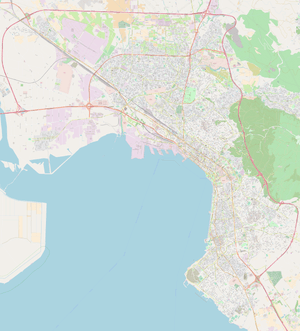Holocaust Museum of Greece
| Μουσείο Ολοκαυτώματος Ελλάδος | |
 | |
 Location within Thessaloniki  Holocaust Museum of Greece (Greece) | |
| Location | Thessaloniki, Greece |
|---|---|
| Coordinates | 40°38′38″N 22°55′05″E / 40.644°N 22.918°E |
| Type |
Holocaust museum Human rights museum |
| Architect |
|
| Website | Official website |
The Holocaust Museum of Greece (Greek: Μουσείο Ολοκαυτώματος Ελλάδος), officially the Holocaust Memorial Museum & Educational Center of Greece on Human Rights, is an under-construction museum on The Holocaust in Thessaloniki, Greece. Its construction was proposed in 2016 and is partly funded by the Federal Republic of Germany (€10 million), with support from the Municipality of Thessaloniki and mayor Yiannis Boutaris.[1] The total construction cost is estimated at €25 million ($28.18 million).[1] The foundation stone was placed on 30 January 2018.[2]
Thessaloniki was chosen over Athens due to the degree to which it suffered during the Second World War. Thessaloniki was from the beginning under German occupation, contrary to most of Greece which was occupied by Italy or Bulgaria. Adolf Hitler planned to incorporate the city into the Third Reich as a reprisal for its involvement in the First World War (Salonica Front).[3]
In 1942 the German forces started implementing the Nuremberg Laws in the city and ordered male Jews to register at Eleftherias Square, where they were publicly tortured and humiliated before being forced into labour.[4][5] A Jewish Ghetto was established near the train station.[6] In 1943 the city's 56,000 Jews were deported, by use of 19 Holocaust trains, to Auschwitz and Bergen-Belsen concentration camps, where 43,000 – 49,000 of them were killed.[7][8][9] The train journey from Thessaloniki to the concentration camps was the longest of all Holocaust trains, and Jews had to buy a ticket.[10]
Between the 15th and early 20th centuries, Thessaloniki was the only city in Europe where Jews were a majority of the population.[1] However, only 2,000 Jews returned after the war and less than 1,000 remain today.[8][9] Overall, 80,000 Greek Jews, or 85% of the total Jewish population, perished in the Holocaust.[11]
See also
References
- 1 2 3 "EXECUTIVE SUMMARY". www.holocausteducenter.gr. Retrieved 2018-09-13.
- ↑ "Mουσείο Ολοκαυτώματος, μνημείο στην Ιστορία". Η Εφημερίδα των Συντακτών (in Greek). 2018-01-31. Retrieved 2018-09-13.
- ↑ Panagiotopoulos, Apostolos (2009). Θεσσαλονίκη ... εν Θερμώ – Ο συγκλονιστικός 20ός αιώνας της πόλης [Thessaloniki ... on Fire – The City's Sensational 20th Century]. B. Maliaris Paideia. p. 753. ISBN 978-960-457-239-7.
- ↑ University of Athens: Faculty of Political Science and Public Administration (1998). Documents on the history of the Greek Jews: records from the historical archives of the Ministry of Foreign Affairs. Kastaniotis Editions.
- ↑ Winstone, Martin (2010-06-30). The Holocaust Sites of Europe: An Historical Guide. I.B.Tauris. ISBN 9780857730282.
- ↑ Jewish Community of Thessaloniki (2005). "Cultural forum of the Jewish community of Thessaloniki". Ets Ahaim Foundation. Retrieved 2018-09-13.
- ↑ Martin Gilbert (1982). The Routledge atlas of the Holocaust. Retrieved 10 August 2011.
- 1 2 Yale Strom (1992). The Expulsion of the Jews: Five Hundred Years of Exodus. Retrieved 13 September 2018.
- 1 2 "Thessaloniki's new Holocaust museum a sign of a city finally embracing its Jewish past". www.timesofisrael.com. The Times of Israel. Retrieved 2018-09-13.
- ↑ "Jews made pay train fares to Auschwitz". 2015-03-23. Retrieved 2018-09-13.
- ↑ Smith, Lyn (2010-09-15). "Forgotten Voices of The Holocaust: A new history in the words of the men and women who survived". Random House. Retrieved 2018-09-13.

